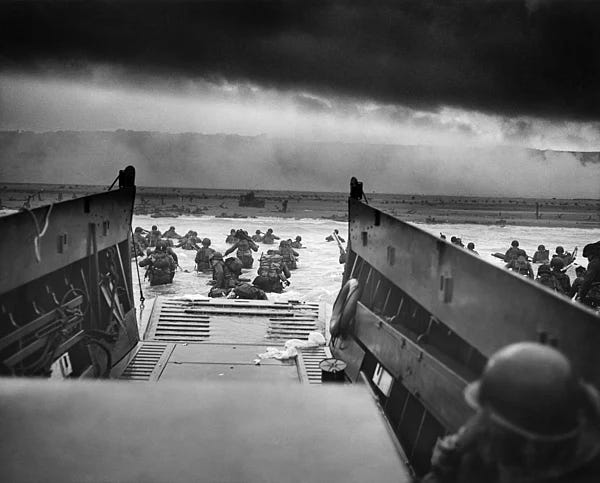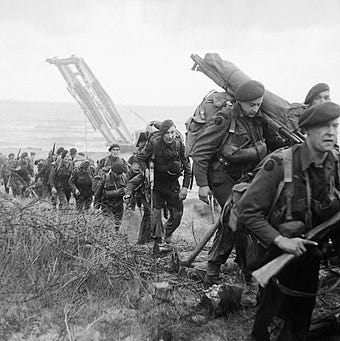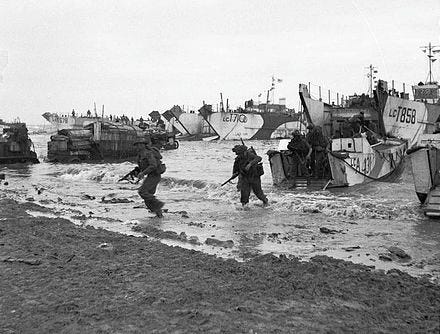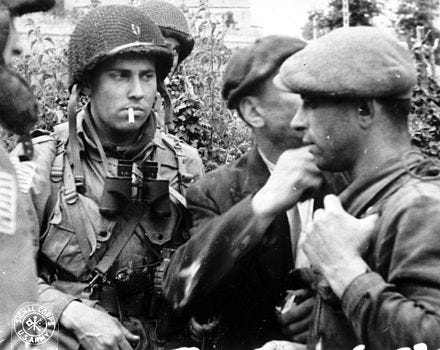Normandy has important visitors today, the last surviving members of the allied forces which began the liberation of Europe from the Nazi yoke. Most of Europe had been occupied since June 1940, only Britain and the British Empire fought on alone until Hitler invaded the Soviet Union a year later and unleashed a bloodbath which devastated the country and slaughtered twenty five million of its people. Eighteen months later, Hitler made the mad decision to declare war on the United States and Stalin began to pressure the western allies to invade Europe and assist the desperate Soviet fight back.
D Day or Operation Overlord was the name given to the Allied invasion of France, 80 years ago today. It took over a year to plan, was the cause of major disagreements between the allies, politicians and commanders, and was the largest invasion undertaken in world history.
Winston Churchill was doubtful about it from the beginning, fearing that it might fail. If it had, it is conceivable that the war may have ended in a lengthy stalemate. Before the American and Russians joined the war Churchill believed that it might last until the 1960s, a quarter of a century after it began.
I’ve not been able to find the reference but I once read that General Eisenhower, Supreme Commander of the allied forces said that the hardest thing he had to do was to speak to the soldiers before they embarked for the beaches, knowing so many of them would die. If you’ve ever seen the opening sequences of Steven Spielberg’s Saving Private Ryan you will see what he meant. Once the doors of the landing craft were opened, the men faced a storm of bullets and mortars. It’s a miracle that more didn’t die.
Planning for the invasion began in March 1943 with a team led by Lieutenant-General Frederick Morgan, Chief of Staff of the Supreme Allied Commander, (thankfully thereafter known by the acronym COSSAC.) His initial staff were an aide, two batman and a driver but by October it had grown to 320 officers and 600 other ranks.
Lieutenant-General Frederick Morgan.
Their plans included the decision to attack in Normandy, a monumental deception operation to fool the German high command into thinking the attack would come near Calais, the development of artificial harbours and equipment to help clear the beaches. Plus all the complex logistics of mounting an invasion of 150,000 men from the following countries: The United Kingdom, the United States, Canada, France, Australia, Czechoslovakia, Poland, the Netherlands, New Zealand, Greece, Norway, South Africa and Southern Rhodesia.
Once the planning stage was over General Eisenhower, Supreme Allied Commander took charge with a team of British and American staff.
Front Row: Sir Arthur Tedder, Deputy Supreme Commander, Dwight D. Eisenhower, Supreme Commander, General Bernard Montgomery.
Back Row: General Omar Bradley, Admiral Sir Bertram Ramsay, Air Chief Marshal Sir Trafford Leigh-Mallory, Chief of Staff, Lieutenant-General Walter Bedell Smith.
Responsibility for naval operations was given to Admiral Sir Bertram Ramsay, who had master-minded the evacuation at Dunkirk. He now organised a vast armada of 7,000 vessels with 200,000 personnel which embarked 160,000 men onto the beaches of Normandy on D-Day alone with over 875,000 landed by the end of the month. On D-Day itself 1,000 bombers and 1,200 transportation planes took to the skies.
Facing them were an army of 50,000 German troops and allies ensconced in the best defences imaginable.
We’ve read so much about the invasion and seen so many films and television programmes, we have grown accustomed to the fact that it was a success. Despite all the meticulous planning and training it was still a colossal gamble. Eisenhower wrote two speeches to read at the end of the day. He read the one proclaiming success but he had penned a second one, admitting failure and that he had ordered to retreat. A failure which may well have lost the war for the allies.
But success came at horrendous cost. There were 10,000 casualties on both the Allied and German sides with 4,000 allied soldiers killed and an unknown number of Germans. The meticulous planning had brought all these men, many of them in their early twenties to this furnace of hell. They fought and died on the beaches, some without even landing. They are commemorated today.










